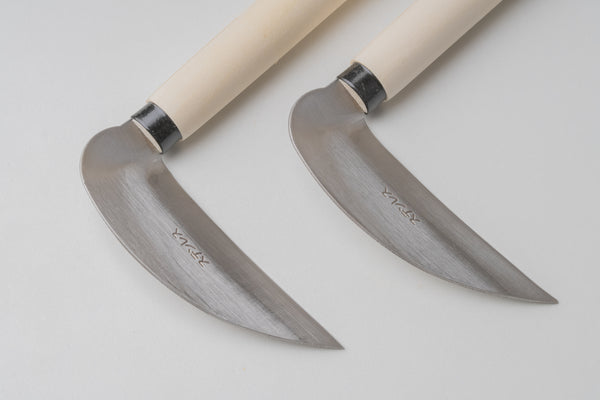How To Sharpen A Japanese Sickle - An In-Depth Guide

Jump to:
When it comes to tools for gardening, lawn care, landscaping and farming, a quality sickle is indispensable.
The curved, hand-held bladed sickle has been a staple in fields and gardens for centuries, serving as a versatile tool for harvesting crops, trimming foliage and clearing grass and overgrown areas. Whether you're a seasoned farmer or a backyard gardener, mastering the art of sickle maintenance is essential for ensuring efficient and safe use.
Sickle blade sharpening is a vital component of proper sickle tool care. A good sharpening restores the sickle blade's razor-sharp edge and enhances its cutting performance. A well-sharpened sickle not only makes your tasks easier but also reduces the risk of injury and extends the tool's lifespan.
In this edition of the Daitool blog, we’ll explore the fundamentals and safety considerations of sickle sharpening, as well as walk through a step-by-step process to keep your trusty sickle in top condition.
What Is a Sickle? How Is It Used?

Sickles have been a vital part of farming and gardening practices for centuries. With its distinctive shape designed to efficiently cut and harvest crops, grasses and other vegetation, sickles are a major player in your tool lineup.
Sickles played a historical role in the development of human civilization, enabling early agricultural societies to harvest crops more efficiently and effectively. Nowadays, sickles remain an indispensable tool for small-scale farmers, gardeners, landscapers – and those who appreciate the simplicity and effectiveness of traditional methods.
Sickles offer a wide range of applications. In gardening, sickles are commonly used for trimming grass, cutting back overgrown plants and harvesting herbs & vegetables. Farmers rely on sickles for harvesting crops like wheat, rice and other grains, as well as for cutting fodder for livestock. Sickles are also heavy hitters when it comes to clearing brush, trimming hedges, cutting weeds and maintaining landscaping in both residential and commercial settings.
With their curved blade and ergonomic design, sickles allow for precise and efficient cutting while minimizing strain on a user's back and arms. Whether you're a professional or a hobbyist, a well-maintained sickle can become a trusted companion in your gardening or farming activities.
Sickle Maintenance: Why It’s Important to Sharpen Your Sickle

Like any cutting tool, a sickle requires regular maintenance to ensure optimal performance and long-lasting results.
Proper sickle tool care not only prolongs the life of your sickle but also contributes to safer and more efficient use, reducing the risk of injury and unnecessary strain.
One of the most crucial aspects of sickle maintenance is sharpening the sickle blade. Over time, the constant use and exposure to various materials can dull the blade, making it less effective at cutting and more prone to slipping or snagging.
A dull sickle blade ends up making tasks more difficult and time-consuming. A poorly sharpened sickle can even pose a safety hazard, as it requires more force to cut, increasing the risk of slips, cuts and/or other injuries.
Why Sharpen a Sickle Regularly (and How Often)?
Sharpening your sickle regularly offers numerous benefits:
- Improved cutting efficiency: A sharp sickle blade slices through vegetation cleanly and effortlessly, reducing the amount of time and energy required for each task
- Extended sickle tool lifespan: Properly sharpening and maintaining the sickle blade helps prevent excessive wear and tear, ensuring your sickle remains in top condition for years to come
- Enhanced safety: A well-sharpened sickle blade is less likely to slip or snag, reducing the risk of accidents and injuries during use
- Cleaner cuts: A sharp sickle blade makes cleaner, more precise cuts, which can be beneficial for the health and appearance of your plants, crops or landscaping
- Regular sharpening optimizes the performance of your sickle,
- It also demonstrates your commitment to caring for your sickles and other tools.
In terms of how often one should sharpen a sickle blade, this is a great question that we’re often asked. The truth is, there’s no hard-and-fast rule when it comes to sickle blade sharpening frequency. Instead, frequency sickle sharpening (like knife sharpening and tool sharpening in general) is a more hands-on, case-by-case process, subject to both how often you use the sickle and in what capacity the sickle is used.
- We recommend sharpening a sickle blade if it’s been a while since you last used it
- Sharpening is also recommended when the sickle has been used heavily, either in terms of time and/or under intense cutting conditions
- If you notice that the sickle blade seems dull in appearance, it’s always best to err on the side of caution and sharpen before use
- If you begin to use the sickle and feel strain in cutting, or notice that it’s taking longer to get the job done, a good sharpening is your go-to solution
By taking the time to sharpen and maintain your sickle, you'll ensure that this invaluable gardening companion remains a handy tool for years to come.
How to Safely Sharpen a Sickle

Sharpening a sickle blade is a fairly straightforward process that requires a few essential materials and some essential safety precautions.
Actually, we really can’t emphasize safety enough when it comes to sickles, tools and work in general!
- Don’t rush the sickle sharpening process
- Don’t skimp out (or altogether forget) proper eye protection and hand protection
- Always remember to check your surroundings, both for your own safety and for the safety of others
By following these step-by-step instructions, you'll be able to restore the razor-sharp edge of your sickle blade, ensuring efficient and safe use for all your gardening, landscaping or farming tasks.
Materials Needed for Proper Sickle Sharpening:
Sickle blade sharpening involves some basic items. Be sure to have these all lined up and ready to go before beginning the sickle sharpening process, as this will save you time and effort in the long run (remember “PPPPP” – proper planning prevents poor performance).
- Sharpening stone (coarse grit for heavy sharpening, fine grit for polishing)
- Clamp or vise to secure the sickle
- Gloves for hand protection
- Eye protection (safety glasses or goggles)
- Lubricating oil or water (for wet sharpening)
- Clean cloth or rag
With these materials all ready to go, it’s important to focus on safety first, before engaging in the sickle sharpening itself.
Safety Precautions for Sickle Sharpening:
- Work in a well-lit, stable and clutter-free area
- Wear protective gloves to avoid cuts or abrasions
- Use eye protection to shield your eyes from flying debris or sparks
- Secure the sickle firmly in a clamp or vise to prevent it from shifting during sharpening
- Keep a firm grip on the sickle and sharpening stone to maintain control
- Always sharpen away from your body, not towards it
Now that the safety briefing is done, it’s time to get that sickle good and sharp!
Step-by-Step Guide for Proper Sickle Sharpening
Here we go, folks, get ready to bring back that sharp performance to your handy sickle blade.
- Secure the sickle
Clamp or secure the sickle tool in a vise, ensuring that the blade is easily accessible and positioned at a comfortable working angle.
- Prepare the sharpening stone
If using a wet stone, lubricate it with water or lubricating oil. For dry stones, ensure they are clean and free of debris. Two stellar sharpening stones that we can heartily recommend for sickle blade sharpening (and many other tool sharpening applications) are: King Deluxe Whetstone Sharpening Stone (800 grit) and Shapton Pro Kuromaku Whetstone (1500 grit).
- Establish the sharpening angle
The ideal sharpening angle for a sickle blade is around 20-25 degrees. Hold the sharpening stone at this angle against the blade's bevel.
- Begin sharpening
With a firm grip on the stone and sickle, apply gentle pressure and make smooth, consistent strokes along the entire length of the blade. Maintain the sharpening angle throughout the process.
- Alternate sides
After several strokes on one side, flip the sickle over and repeat the process on the other side. This ensures even sharpening and prevents the sickle blade from becoming lopsided.
- Check the edge
Periodically check the edge of the sickle for sharpness by gently running your finger across the blade (away from the sharp edge, of course). A well-sharpened edge should catch slightly on your fingerprint ridges.
- Refine the edge
Once the desired sharpness is achieved, switch to a finer grit sharpening stone or honing rod to polish and refine the edge.
- Clean and oil
After sharpening, wipe away any metal filings or debris from the sickle blade with a clean cloth. Apply a thin layer of protective oil to prevent rust and corrosion.
Additional Notes & Suggestions – Sickle Blade Sharpening
We’ve covered the basics of sickle sharpening, but here are a few more things worth keeping in mind.
- For best results, sharpen your sickle (& tools with blades in general) regularly, even if it doesn't seem dull; frequent light sharpening is easier and extends the blade's life compared to letting it become excessively dull
- A sharpening file is a handy tool for sickle blade sharpening and other tool sharpening – handy because it can be used without water
- Consider investing in a sharpening guide or jig designed specifically for sickles or curved blades, to help maintain the correct sharpening angle consistently
- If you're new to sharpening, practice on an old or inexpensive sickle first to get a feel for the process before working on your primary tool
- Avoid using power tools or grinding wheels to sharpen sickles, as the high speed and heat can damage or warp the thin blade
- Store your sharpened sickle properly, with the blade protected to prevent accidental damage or dulling
- For heavily pitted or damaged sickle blades, you may need to have it professionally sharpened or replaced by a qualified sharpening service
Remember, sharpening a sickle requires patience and practice. Take your time, focus on maintaining the proper sharpening angle; and prioritize safety throughout the process.
With a well-sharpened sickle in hand, you'll be ready to tackle that gardening, landscaping or farming task with precision and ease.
Sickle Blade Sharpening for Optimum Performance & Lifespan

Mastering the art of sickle sharpening is an important skill for any gardener, landscaper or farmer who is dedicated to quality tools and efficient work.
By following the step-by-step guide outlined in this article, you'll be able to keep your trusty sickle in top condition, ensuring clean cuts, improved safety and a longer sickle tool lifespan.
Remember, a well-sharpened sickle is not only more efficient but also reduces the risk of injury and strain, making your gardening or farming tasks safer and more enjoyable.
Regular sickle blade sharpening is a small investment of time that pays dividends in the form of improved performance and longevity for your sickle.

0 comments